Lawn renovation
Learn causes of lawn failure, how to repair injury in small areas, the impact of soil compaction, methods of renovation and turfgrass selection.
Introduction
Renovation refers to the repair and improvement of an existing lawn without complete reestablishment of the turf cover. Renovation practices avoid the labour and cost of completely redoing the lawn. In most cases lawn renovation is preferable over total lawn reestablishment because it is less labour intensive; there is minimum erosion or mud; some foot traffic can be tolerated during the process and generally results can be observed more readily.
10 reasons for renovation
Before any renovation is done the cause of the turf damage should be determined. The following reasons can be the cause of lawn failure:
- Thatch accumulation (Figure 1)
- Weeds have infested the lawn
- Disease damage (Figure 2)
- Insect damage
- Excessive use
- Poor maintenance
- Winter injury/drought injury
- Soil compaction
- Poor drainage
- Grasses in lawn not suited to the growing conditions
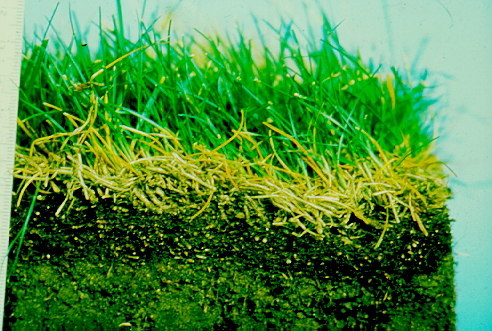
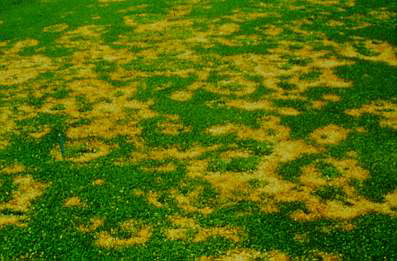
Repairing injury in small areas
Sections of a lawn are frequently injured by diseases and insects.
Where the amount of injury is small and a large proportion of live grass remains in the injured areas, raise the mowing height to 5 cm, increase the number of fertilizer applications (as many as five or six, starting early April and ending mid September), and increase the frequency of irrigation to stimulate the lawn into rapid growth to heal the damaged areas. Once the injured area has been filled in, the fertilizer, irrigation and mowing program should be returned to normal.
For immediate results, spot sodding can also be done to repair areas of the lawn. Prepare the soil as for seeding but allow for the thickness of the sod to be at the same level as the existing lawn. Maintain good moisture until the sod is well rooted. Resodding can be done throughout the season providing irrigation is available.
Occasionally, grassy weed problems such as clumps of orchardgrass, or tall fescue may occur in areas of the lawn (Figure 3). These weed problems can be corrected by digging them out. On high maintenance lawns patches of creeping bentgrass may appear. Raking the area and reducing the watering frequency may assist in reducing the bentgrass. Quack grass is generally only a problem in poorly maintained lawns.
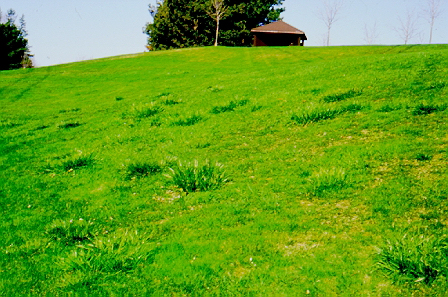
By increasing fertility and maintenance of the lawn the turf can usually crowd out the quackgrass.
Soil compaction
While not often a major problem on the average home lawn, soil compaction may occur when there is frequent foot traffic on the area. Foot traffic causes the first 2 to 3 cm of the rootzone to become compacted. This reduces water infiltration and deprives the roots of the oxygen they need. On lawns where compacted soil conditions exist, the root system tends to be very shallow and the lawn is not as tolerant to stresses such as drought or diseases. Turf which is thinned from moderate foot traffic may be improved through the use of equipment such as a core aerator. The hollow steel tines (1–2 cm in diameter and 10–15 cm apart) of these machines remove cores of compacted soil (Figure 4). The compacted cores may be removed from the lawn and replaced with uncompacted topsoil or compost.
Under heavy foot traffic conditions lawn areas may require aeration twice during the season. Spring and early fall are the recommended times to aerate. The best condition for aeration is when there is adequate soil moisture. If soil is dry, the coring machine will not go as deep and will have less of an effect. On the other hand, if the soil is too wet, further compaction to the area may result.
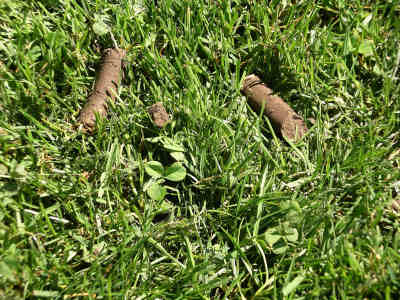
Methods of renovation
Overseeding is a method of establishing new turfgrass plants by seed with a minimum of disturbance to the existing turf. Success is dependent upon placing the seed in contact with the soil and irrigating frequently enough to prevent drought stress of the seedlings.
There are several techniques by which overseeding can be accomplished:
- Mow the lawn at a low height to improve the success of overseeding. With a garden rake or verticutting machine remove the thatch and debris from the area to be overseeded. Uniformly distribute the desired seed mixture at approximately double the seeding rate recommended for establishment of a new lawn. Apply half of the seed in one direction and apply the other half at right angles to the first seeding direction. Ensure that the seed is in contact with the soil beneath. Spread topsoil or compost over the overseeded area at the rate of 0.5 m3/100 m2 of lawn area. The topsoil should be firmly rolled to ensure that it is in contact with the seed. The seedbed should be watered often enough so that it remains moist. Better results from this broadcast method may be obtained by using a coring or verticutting machine first because more soil contact is achieved.
- Another successful method is to overseed the area with a slit or disk overseeder. This type of seeder has rotating vertical blades which cut a slit through the thatch layer (the thatch and debris need not be removed as in method 1) to the soil beneath. The disk holds the slit open while the seed drops down into the slit. Overseed in two directions perpendicular to one another. This method is rapid, may be done during the normal seeding times (spring and fall) and has a high degree of success (Figure 5).
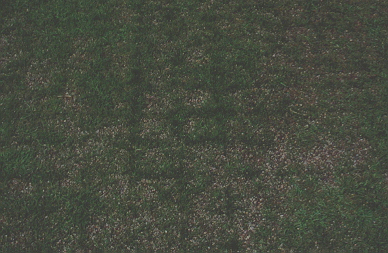
If proper maintenance practices are not followed after renovation is completed the lawn will deteriorate within several years. For more information refer to the OMAFRA fact sheet Lawn maintenance.
Turfgrass selection
Lawn renovation provides the opportunity to convert the lawn to more suitable species and varieties of turfgrasses. Many improved varieties of Kentucky bluegrass, fine fescue and perennial ryegrass have been developed and are superior in performance and quality to the older varieties that may have been used when the lawn was established. When selecting grass seed to renovate small areas of the lawn it is important to attempt to use a seed mixture or seed blend similar in colour, texture and growth habit of the existing lawn grasses to avoid a patchy appearance. For overseeding, "turf type " perennial ryegrass is a good choice because of its quick germination and establishment.
If renovation is required because of damage from lawn disease problems such as necrotic ring spot, "turf type" perennial ryegrass should be used. This species is more resistant to this disease than Kentucky bluegrass. "Turf type" perennial ryegrass is more similar in growth habit to other lawn grasses and more winter hardy than common perennial ryegrass.
Lawn reestablishment
If lawn performance has deteriorated due to poor soils which need soil modification or if the soil is poorly drained or in need of regrading, renovation should not be done until these problems are corrected as the results will be short-lived. Problems of this nature generally require total lawn reestablishment. Refer to OMAFRA fact sheet, Lawn establishment for additional information.
This factsheet was originally authored by J.L. Eggens and has been revised by Pam Charbonneau.